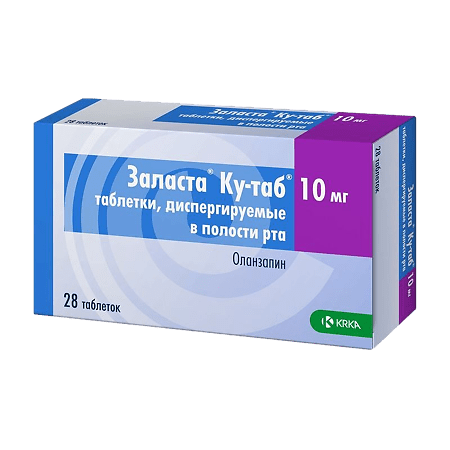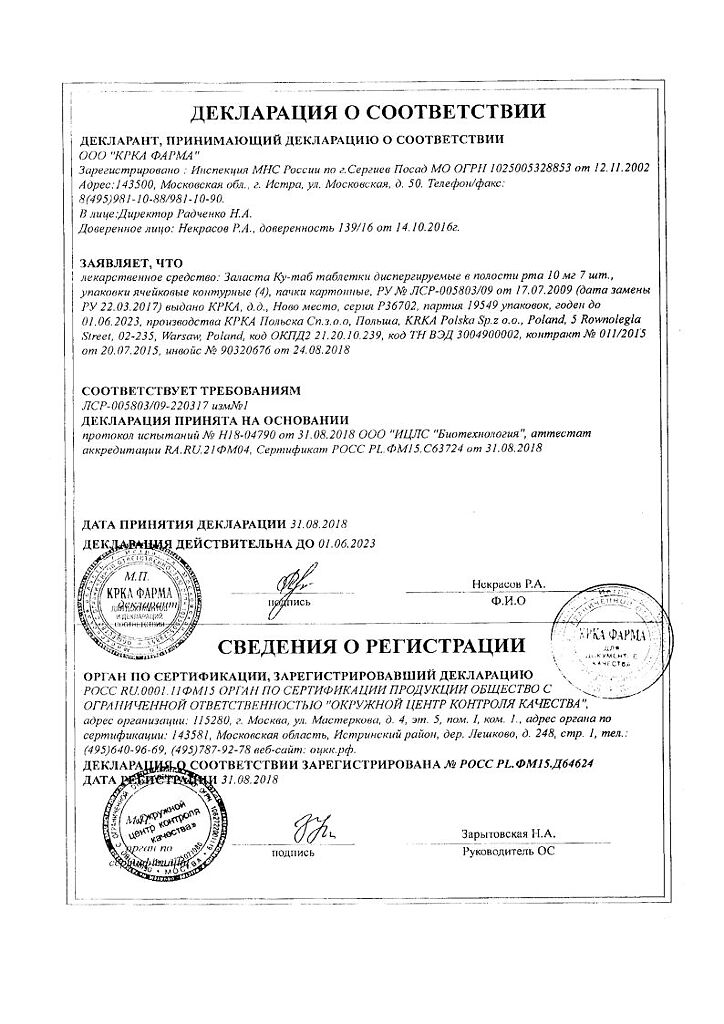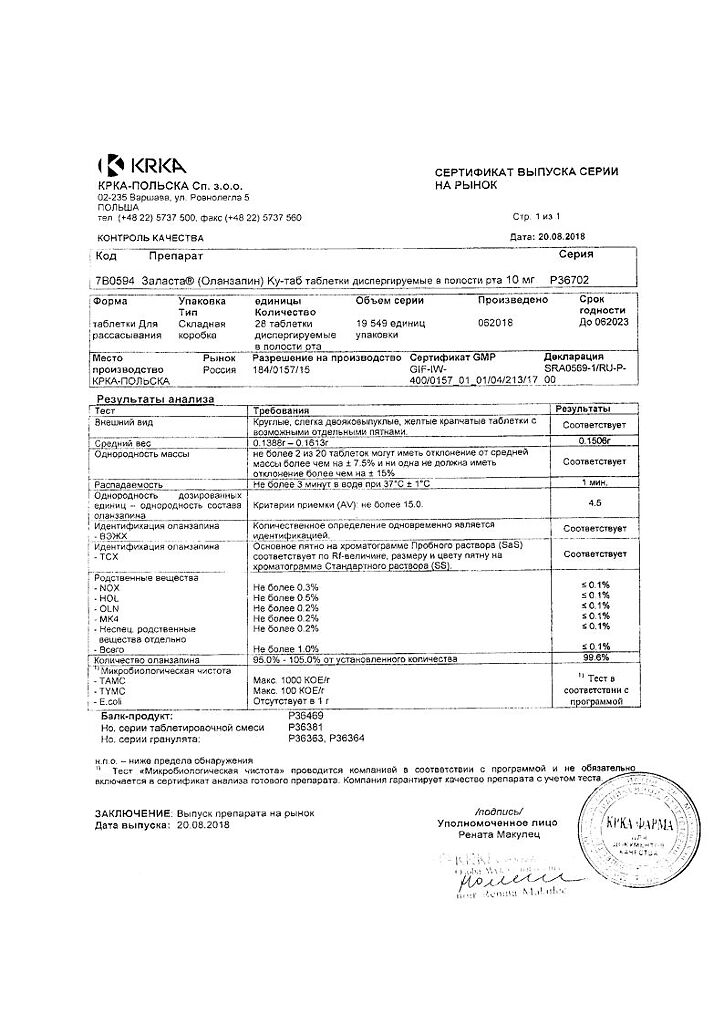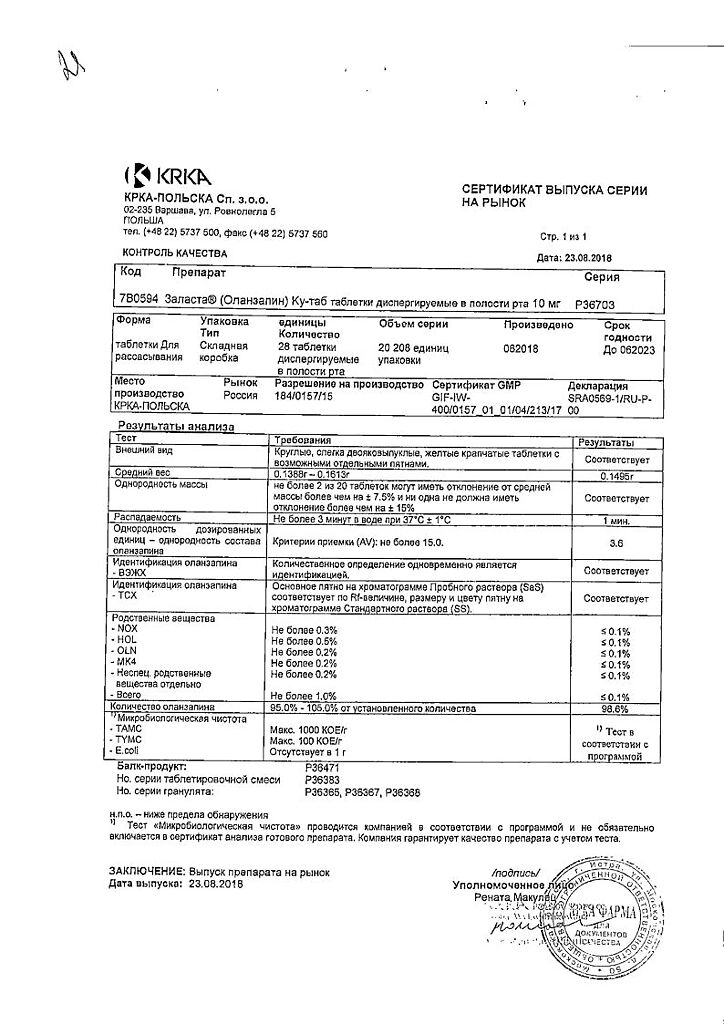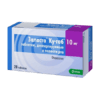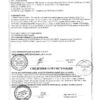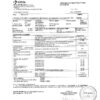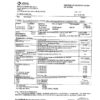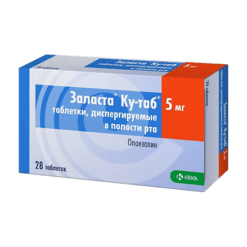No products in the cart.
Zalasta Ku-tab, 10 mg 28 pcs
€25.61 €21.34
Out of stock
(E-mail when Stock is available)
Description
Manic Depressive Psychosis, Schizophrenia, Anxiety
Adults
– Olanzapine is indicated for treatment of schizophrenia.
-Olanzapine is effective in maintenance and long-term therapy in patients with schizophrenia who have seen initial treatment effects.
– Olanzapine is indicated for treatment of a moderate to severe manic episode.
– Olanzapine is indicated for relapse prevention in patients with bipolar disorder in whom it has shown efficacy in treating a manic episode.
Indications
Indications
Adults
· Olanzapine is indicated for the treatment of schizophrenia.
· Olanzapine is effective in maintenance and long-term therapy in patients with schizophrenia who have responded to initial treatment.
· Olanzapine is indicated for the treatment of moderate to severe manic episodes.
· Olanzapine is indicated for the prevention of relapse in patients with bipolar disorder, in whom it has been shown to be effective in treating a manic episode.
Pharmacological effect
Pharmacological effect
antipsychotic (neuroleptic)
Special instructions
Special instructions
Contraindicated for persons under 18 years of age.
Elderly patients
A minimum starting dose (5 mg per day) is not usually prescribed, but its use should be considered in patients ≥65 years of age if the individual patient’s clinical condition warrants it.
Patients with renal and/or liver failure
Patients with renal and/or liver failure should begin treatment with a minimum dose (5 mg per day). For moderate liver failure (cirrhosis, Child-Pugh class A or B), the initial dose should be 5 mg, and if necessary, the dose should be increased with caution.
Clinical improvement with antipsychotic treatment may occur within a few days to several weeks. Careful monitoring of patients during this period is required.
Psychosis due to dementia and/or behavior disorder
Olanzapine is not indicated for the treatment of psychosis associated with dementia and/or behavioral disorders due to the increased mortality and risk of cerebrovascular accidents in these patients. In placebo-controlled studies (lasting 6 to 12 weeks) in elderly patients (mean age 78 years) with dementia-related psychosis and/or behavioral disturbances, there was a two-fold increase in deaths in the olanzapine group compared with the placebo group (3.5% and 1.5%, respectively). The higher mortality rate was not associated with the dose of olanzapine (mean dose 4.4 mg) or duration of treatment. Risk factors that may predispose this group of patients to higher mortality when treated with olanzapine include age >65 years, dysphagia, sedation, malnutrition and dehydration, presence of pulmonary pathology (eg, pneumonia with or without aspiration), or concomitant use with benzodiazepines. However, the incidence of death was higher in patients treated with olanzapine compared with patients treated with placebo, regardless of these risk factors.
In the same clinical studies, cerebrovascular adverse events (eg, stroke, transient ischemic attack), including fatal cases, were observed. In placebo-controlled studies, there was a threefold higher incidence of cerebrovascular adverse events in patients in the olanzapine group compared with the placebo group (1.3% versus 0.4%, respectively). All patients with cerebrovascular events treated with olanzapine and placebo had preexisting risk factors for cerebrovascular adverse events. Age >75 years and vascular or mixed dementia were identified as risk factors for cerebrovascular adverse events during treatment with olanzapine. The effectiveness of olanzapine was not established in these studies.
Parkinson’s disease
The use of olanzapine is not recommended in the treatment of psychosis induced by dopamine receptor agonists in Parkinson’s disease.
In clinical trials, worsening Parkinson’s disease symptoms and hallucinations were reported very frequently and at a higher rate than placebo, and olanzapine was not superior to placebo in treating psychotic symptoms. In these clinical studies, patients were initially required to stabilize on the lowest effective dose of Parkinson’s disease medications (dopamine agonists) and continue to take them at the same dose throughout the study. The starting dose of olanzapine was 2.5 mg per day and could be increased to a maximum of 15 mg per day at the discretion of the investigator.
Neuroleptic malignant syndrome (NMS)
Neuroleptic malignant syndrome is a potentially life-threatening condition that occurs during the use of antipsychotic drugs. Rare cases of NMS have also been reported with olanzapine. Clinical manifestations of NMS include hyperpyrexia, muscle rigidity, altered mental status, and autonomic disturbances (irregular pulse or blood pressure, tachycardia, diaphoresis, and cardiac arrhythmias). Additional signs may include increased CPK activity, myoglobinuria (rhabdomyolysis), and acute renal failure. Clinical manifestations of NMS or a significant unexplained increase in body temperature without other symptoms of NMS require discontinuation of all antipsychotics, including olanzapine.
Hyperglycemia and diabetes mellitus
Cases of hyperglycemia and/or development or decompensation of diabetes mellitus, in some cases accompanied by ketoacidosis and diabetic coma, including death, have been reported infrequently. In some cases, there was an increase in body weight, which could serve as a predisposing factor. Close clinical monitoring of patients with diabetes mellitus and patients with risk factors for developing diabetes mellitus is recommended according to the following guidelines: measurement of blood glucose concentrations at baseline, 12 weeks after starting olanzapine, and annually thereafter. Patients taking antipsychotic drugs, including olanzapine, should be monitored for signs and symptoms of hyperglycemia (such as polydipsia, polyuria, polyphagia, weakness). Patients with diabetes mellitus or risk factors for diabetes mellitus require regular monitoring of blood glucose concentrations. Regular monitoring of body weight is necessary: before starting treatment, 4, 8 and 12 weeks after starting olanzapine, and subsequently every 3 months.
Change in lipid profile
In placebo-controlled studies, undesirable lipid changes were observed in patients receiving olanzapine. Changes in the lipid profile should be adjusted according to clinical need, especially in patients with dyslipidemia and in patients with risk factors for developing lipid disorders. Patients taking antipsychotic drugs, including olanzapine, should have their lipid profile checked regularly as recommended: before starting treatment, 12 weeks after starting olanzapine, and every 5 years thereafter.
Anticholinergic activity
Although olanzapine exhibited anticholinergic activity in in vitro studies, the use of olanzapine in clinical studies revealed a low incidence of associated complications. However, since clinical experience with olanzapine in patients with underlying medical conditions is limited, caution should be exercised when prescribing olanzapine in patients with clinically significant prostatic hypertrophy, paralytic ileus, and similar conditions.
Liver dysfunction
Often, especially in the early stages of therapy, a transient asymptomatic increase in the activity of “liver” aminotransferases (AST and ALT) was noted. Particular caution is warranted when increasing serum AST and/or AJIT activity in patients with symptoms of liver dysfunction, previously diagnosed conditions associated with limited liver functional reserve, or in patients receiving treatment with potentially hepatotoxic drugs. If hepatitis (including hepatocellular, cholestatic or mixed) is diagnosed, olanzapine should be discontinued.
Neutropenia
Olanzapine should be used with caution in patients with low white blood cell and/or neutrophil counts; in patients receiving drugs that can cause neutropenia; in patients with a history of drug suppression of bone marrow function; in patients with suppression of bone marrow function due to concomitant disease, radiation or chemotherapy; and in patients with eosinophilia or myeloproliferative diseases. Cases of neutropenia have been frequently reported with concomitant use of olanzapine and valproate.
Discontinuation of therapy
In rare cases (≥ 0.01% and < 0.1%), the following acute symptoms were observed when olanzapine was abruptly stopped: increased sweating, insomnia, tremor, anxiety, nausea or vomiting.
QT interval
In clinical trials, clinically significant prolongation of the QTc interval (QTcF > 500 ms at any time after the start of treatment with a baseline QTcF < 500 ms) occurred infrequently (0.1%-1%) in patients receiving olanzapine, with no significant difference in associated cardiac events compared with placebo. However, caution should be exercised when prescribing olanzapine with drugs that increase the QTc interval, especially in elderly patients with congenital long QT syndrome, congestive heart failure, cardiac hypertrophy, hypokalemia and hypomagnesemia.
Thromboembolism
Infrequently (<0.1% and <1%) cases of a temporal association between the development of venous thromboembolism and olanzapine therapy have been reported. The presence of a cause-and-effect relationship between olanzapine and venous thromboembolism has not been established. However, given that patients with schizophrenia often have acquired risk factors for the development of thromboembolism, all possible risk factors for this complication, including immobilization of patients, should be identified and the necessary preventive measures should be taken.
General activity in relation to the central nervous system
Given the primary central nervous system effects of olanzapine, caution should be exercised when olanzapine is used in combination with other centrally acting drugs and alcohol. Because olanzapine can antagonize dopamine receptors in vitro, it may antagonize the effects of direct and indirect dopamine receptor agonists.
Convulsions
Olanzapine should be used with caution in patients with a history of seizures or exposure to factors that lower the seizure threshold. Cases of seizures were uncommon in patients taking olanzapine, and most of these cases reported a history of seizures or risk factors for seizures.
Tardive dyskinesia
In comparative studies lasting up to a year, treatment with olanzapine was significantly less likely to be accompanied by the development of dyskinesia requiring drug correction. However, the increased risk of tardive dyskinesia should be taken into account with long-term therapy with antipsychotics. If signs of tardive dyskinesia develop, it is recommended to reduce the dose or discontinue olanzapine. Symptoms of tardive dyskinesia may increase or manifest after discontinuation of the drug.
Postural hypotension
Postural hypotension was observed infrequently in clinical studies of olanzapine in elderly patients. It is recommended to periodically measure blood pressure in patients over 65 years of age.
Sudden death from cardiovascular failure
A case of sudden death has been reported following post-marketing surveillance of olanzapine. In a retrospective observational study, the risk of suspected sudden cardiovascular death in patients receiving olanzapine was approximately twice that of patients not taking antipsychotics. In this study, the risk with olanzapine was comparable to the risk with the atypical antipsychotics included in the pooled analysis.
Use of olanzapine in children
Olanzapine is not recommended for use in children and adolescents. In studies in adolescents 13-17 years of age, various adverse reactions were reported, including weight gain, lipid metabolism disorders, and hyperprolactinemia.
Special information on excipients
Zalasta® Ku-tab® contains aspartame, which is a source of phenylalanine. The drug may not be safe for people with phenylketonuria.
No studies have been conducted on the effect of the drug on the ability to drive vehicles and operate machinery. Patients taking olanzapine should be careful when operating vehicles or machinery as olanzapine may cause drowsiness and dizziness.
Active ingredient
Active ingredient
Olanzapine
Composition
Composition
for 1 tablet, dispersible in the oral cavity, 5 mg/7.5 mg/10 mg/15 mg/20 mg
Active ingredient: olanzapine 5.00 mg/7.50 mg/10.00 mg/15.00 mg/20.00 mg
Excipients: mannitol, microcrystalline cellulose, crospovidone, low-substituted hypromellose LH-21, aspartame, calcium silicate, magnesium stearate
Pregnancy
Pregnancy
Pregnancy
No studies have been conducted on the use of olanzapine in pregnant women. Patients should be warned that if pregnancy occurs or is planned during treatment with olanzapine, they should inform their doctor. Due to insufficient experience with the use of olanzapine during pregnancy, the drug should be prescribed during pregnancy only if the potential benefit to the patient significantly outweighs the potential risk to the fetus.
Newborns whose mothers took antipsychotics (including olanzapine) in the third trimester of pregnancy are at risk of developing adverse reactions, including extrapyramidal disorders and withdrawal symptoms, varying in severity and duration. Cases of agitation, hypertension, hypotonia, tremor, somnolence, respiratory distress, and impaired sucking have been reported. In this regard, newborns whose mothers took olanzapine should be monitored.
Breastfeeding period
The study found that olanzapine is excreted in breast milk. The mean dose received by the child (mg/kg) at maternal steady-state concentration was 1.8% of the maternal olanzapine dose (mg/kg). Breastfeeding is not recommended during olanzapine therapy.
Fertility
The effect on fertility is unknown.
Contraindications
Contraindications
· Hypersensitivity to any of the components of the drug.
· Patients at risk of developing angle-closure glaucoma.
· Children under 18 years of age.
· Patients with phenylketonuria.
Interaction
Interaction
Potential interactions affecting olanzapine
Since olanzapine is metabolized with the participation of the CYP1A2 isoenzyme, the metabolism of olanzapine may be altered by inhibitors or inducers of cytochrome P450 isoenzymes that exhibit specific activity against the CYP1A2 isoenzyme.
Induction of the CYP1A2 isoenzyme
The metabolism of olanzapine can be induced by smoking or carbamazepine, which may result in decreased olanzapine concentrations. There was only a small to moderate increase in olanzapine clearance. Clinical manifestations are likely to be limited, but clinical monitoring and, if necessary, increasing the dose of olanzapine are recommended.
Inhibition of the CYP1A2 isoenzyme
Fluvoxamine, a specific inhibitor of the CYP1A2 isoenzyme, significantly inhibits the metabolism of olanzapine. Olanzapine Cmax after fluvoxamine administration increased by an average of 54% in female nonsmoking patients and by 77% in male smoking patients, and the olanzapine AUC (area under the concentration-time curve) increased by an average of 52% and 108%, respectively. A lower initial dose of olanzapine should be considered in patients using fluvoxamine or other CYP1A2 inhibitors, such as ciprofloxacin. When starting to use drugs related to CYP1A2 isoenzyme inhibitors while taking olanzapine, the possibility of reducing the dose of the latter should be considered.
Decreased bioavailability
Activated charcoal reduces the oral bioavailability of olanzapine by 50-60% and should be used at least 2 hours before or after olanzapine administration.
Fluoxetine (inhibitor of the CYP2D6 isoenzyme), single doses of antacids (aluminium- and magnesium-containing) and cimetidine do not have a significant effect on the pharmacokinetics of olanzapine.
The ability of olanzapine to influence the pharmacokinetics of other drugs
Olanzapine may inhibit the effects of direct and indirect dopamine agonists.
Olanzapine does not inhibit major CYP450 isoenzymes in vitro (eg, 1A2, 2D6, 2C9, 2C19, 3A4). Based on in vivo studies, the following drugs are not expected to interact significantly with olanzapine: tricyclic antidepressants (metabolized primarily by CYP2D6), warfarin (CYP2C19), theophylline (CYP1A2) and diazepam (CYP3A4 and CYP2C19).
Olanzapine did not interact with lithium and biperiden.
Monitoring of valproate plasma concentrations did not reveal the need for valproate dose adjustment after initiation of its use with olanzapine.
General activity of the central nervous system (CNS)
Caution should be exercised when using olanzapine in patients who drink alcohol or are receiving medications that cause CNS depression.
Concomitant use of olanzapine with antiparkinsonian drugs in patients with Parkinson’s disease and dementia is not recommended.
QTc interval
Caution should be exercised when concomitantly using olanzapine with drugs that can prolong the QTc interval.
Overdose
Overdose
Symptoms: very common (≥ 10%) symptoms in olanzapine overdose were tachycardia, psychomotor agitation/aggression, dysarthria, various extrapyramidal disorders and disturbances of consciousness of varying severity (from sedation to coma).
Other clinically significant effects of olanzapine overdose included delirium, seizures, neuroleptic malignant syndrome (NMS), respiratory depression, aspiration, increases and decreases in blood pressure, cardiac arrhythmias (<2% of overdose cases), and cardiac and respiratory arrest. The minimum dose for an acute overdose with a fatal outcome was 450 mg, the maximum dose for an overdose with a favorable outcome (survival) was 2 g of olanzapine.
Treatment: There is no specific antidote for olanzapine. Inducing vomiting is not recommended. Standard procedures for overdose are indicated (gastric lavage, taking activated charcoal). Co-administration of activated carbon and olanzapine showed a decrease in the bioavailability of olanzapine when taken orally by up to 50-60%.
Symptomatic treatment and monitoring of vital organ functions should be provided depending on the clinical picture, including treatment of arterial hypotension and vascular collapse and maintenance of respiratory function. Epinephrine, dopamine and other sympathomimetics that are beta-adrenergic agonists should not be used, since stimulation of these receptors may exacerbate hypotension. It is necessary to monitor cardiovascular parameters to identify possible arrhythmias. Careful monitoring of the patient’s condition is necessary until his complete recovery.
Clinical pharmacology
Clinical pharmacology
Pharmacodynamics
Olanzapine is an antipsychotic drug (neuroleptic) with a wide pharmacological spectrum of effects on a number of receptor systems. Preclinical studies have established the affinity of olanzapine for serotonin 5HT2A/2C, 5HT3, 5HT6; dopamine D1, D2, D3, D4, D5; muscarinic M1-5; adrenergic α1 and histamine H1 receptors. Experiments on animals revealed the presence of olanzapine antagonism towards 5HT, dopamine and cholinergic receptors. Under in vitro and in vivo conditions, olanzapine has a more pronounced affinity and activity for serotonin 5HT2 receptors compared to dopamine D2 receptors. According to electrophysiological studies, olanzapine selectively reduces the excitability of mesolimbic (A10) dopaminergic neurons, and at the same time has a slight effect on striatal (A9) nerve pathways involved in the regulation of motor functions. Olanzapine reduces the conditioned defense response (a test that characterizes antipsychotic activity) at doses lower than doses that cause catalepsy (a disorder reflecting side effects on motor function). Unlike other antipsychotics, olanzapine enhances the anti-anxiety effect when performing the “anxiolytic” test. Olanzapine provides a statistically significant reduction in both productive (delusions, hallucinations, etc.) and negative disorders.
Pharmacokinetics
Olanzapine Orally Dispersible Tablets are bioequivalent to Olanzapine Tablets and have a similar rate and extent of absorption. Olanzapine oral dispersible tablets can be used instead of olanzapine tablets.
Suction
After oral administration, olanzapine is well absorbed, and its maximum concentration (Cmax) in plasma is reached after 5-8 hours. The absorption of olanzapine does not depend on food intake.
Distribution
At plasma concentrations from 7 to 1000 ng/ml, about 93% of olanzapine is bound to plasma proteins. Olanzapine binds mainly to albumin and a1-acid glycoprotein.
Metabolism
Olanzapine is metabolized in the liver as a result of conjugation and oxidation processes. The main circulating metabolite is 10-N-glucuronide, which theoretically does not cross the blood-brain barrier. Isoenzymes CYP1A2 and CYP2D6 of the cytochrome P450 system are involved in the formation of N-desmethyl and 2-hydroxymethyl metabolites of olanzapine. Both metabolites had significantly less pharmacological activity in vivo than olanzapine in animal studies. The main pharmacological activity of the drug is due to the parent substance – olanzapine.
Withdrawal
After oral administration, the mean half-life (T1/2) of olanzapine in healthy volunteers varied depending on age and gender.
In healthy elderly volunteers (65 years and older), the average T1/2 was slow (51.8 hours), and clearance was reduced (17.5 l/h) compared to similar indicators in younger individuals (33.8 hours and 18.2 l/h, respectively).
In women, compared to men, the mean T1/2 was slower (36.7 hours compared to 32.3 hours), and olanzapine plasma clearance was reduced (18.9 l/h compared to 27.3 l/h).
Patients with impaired renal function
In patients with impaired renal function (creatinine clearance <10 ml/min) compared with healthy volunteers, there were no significant differences in mean T1/2 (37.7 hours compared with 32.4 hours) and clearance (21.2 l/h compared with 25.0 l/h). About 57% of radiolabeled olanzapine was excreted by the kidneys, mainly in the form of metabolites.
Patients with liver dysfunction
A small study of the effect of hepatic impairment with oral olanzapine (2.5-7.5 mg single dose) in 6 patients with clinically significant Child-Pugh class A (n=5) and class B (n=1) cirrhosis revealed a minor effect on pharmacokinetics: patients with mild to moderate hepatic impairment had a slight increase in systemic clearance and shortening T1/2 compared with patients without impairment liver function (n=3). There were more smokers among people with cirrhosis (4/6; 67%) than among people without liver dysfunction (0/3; 0%).
Patients who smoke
In smoking patients with mild hepatic impairment, the mean T1/2 was shorter (39.3 hours), and clearance was higher (18.0 l/h) compared to similar indicators in non-smoking healthy volunteers (48.8 hours and 14.1 l/h, respectively).
In non-smoking patients (male and female), the mean T1/2 of olanzapine was longer than that in smoking patients (38.6 hours and 30.4 hours), and the clearance was lower (18.6 l/h and 27.7 l/h).
Plasma clearance of olanzapine was lower in elderly patients compared to younger patients, in women compared to men, and in non-smokers compared to smokers. However, the effect of age, sex, or smoking on olanzapine plasma clearance and olanzapine T1/2 is small compared with the overall interpatient variability.
In a study involving subjects of European, Japanese and Chinese ancestry, there were no differences in the pharmacokinetics of olanzapine associated with race.
Storage conditions
Storage conditions
Storage conditions
At a temperature not exceeding 25 ºС, in the original packaging.
Keep out of the reach of children.
Shelf life
Shelf life
Best before date
5 years.
Do not use the drug after the expiration date.
Manufacturer
Manufacturer
KRKA dd Novo Mesto, Slovenia
Additional information
| Shelf life | Period 5 years. tab-stops: 45.8pt 91.6pt 137.4pt 183.2pt 229.0pt 274.8pt 320.6pt 366.4pt 412.2pt 458.0pt 503.8pt 549.6pt 595.4pt 641.2pt 687.0pt 732.8pt;"> Do not use the product after the expiration date. |
|---|---|
| Conditions of storage | Storage conditions At the temperature not more than 25 ºС, in the original package. Keep out of reach of children. . |
| Manufacturer | KRKA-RUS/KRKA, Russia |
| Medication form | dispersible tablets |
| Brand | KRKA-RUS/KRKA |
Other forms…
Related products
Buy Zalasta Ku-tab, 10 mg 28 pcs with delivery to USA, UK, Europe and over 120 other countries.

